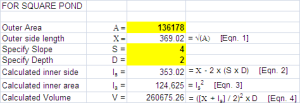POND-SIZE-ESTIMATE.xls

Description
This is a simple pond size estimator for the Civil Engineering Stormwater modeling. Based on a square pond. Please note that this spreadsheet is password protected and cell formulae cannot be seen. Brought to you by www.mckeonengineering.com
Calculation Reference
Hydraulics
A simple rectangular pond size estimator can be used in civil engineering stormwater modeling to estimate the required size of a stormwater pond for managing runoff. Here's a basic method to determine the dimensions of a rectangular pond:
-
Determine the desired storage volume (V) needed to control the runoff. This is typically based on local regulations and is calculated using the Rational Method or the Soil Conservation Service (SCS) Curve Number (CN) Method.
-
Choose an appropriate depth (d) for the pond. The depth should be sufficient to store the required volume while also considering safety, maintenance, and potential evaporation rates. A typical depth range for stormwater ponds is 3 to 10 feet (0.9 to 3 meters).
-
Select an appropriate length-to-width ratio (L:W) for the pond. This ratio depends on the site constraints and the desired shape of the pond. Common L:W ratios are between 2:1 and 4:1.
-
Calculate the area (A) of the pond using the desired storage volume (V) and the chosen depth (d):
A = V / d
-
Determine the length (L) and width (W) of the pond by applying the chosen length-to-width ratio (L:W):
L = W * (L:W)
Substituting A = L * W:
W^2 * (L:W) = A
Solve for W, and then calculate L.
-
Adjust the length and width as necessary to account for site constraints or additional design requirements.
Keep in mind that this method provides a basic estimate of the pond size and may not account for all factors, such as infiltration, evaporation, or sedimentation. It is crucial to consult local regulations and guidelines when designing stormwater management facilities. Additionally, complex projects may require more advanced hydrologic and hydraulic modeling.
Calculation Preview
Full download access to any calculation is available to users with a paid or awarded subscription (XLC Pro).
Subscriptions are free to contributors to the site, alternatively they can be purchased.
Click here for information on subscriptions.

